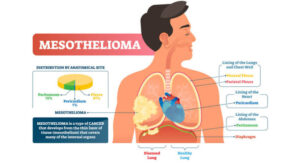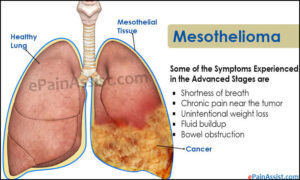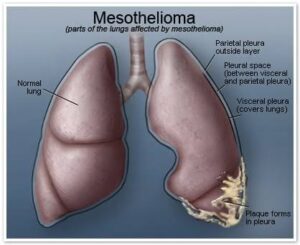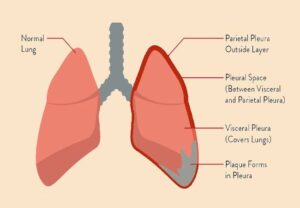
Mesothelioma is rare cancer that is aggressive and deadly when exposed to Asbestos Fibers. These are linked to occupational and environmental exposure such as Construction sites, shipyards, manufacturing facilities and insulation jobs.
Mesothelioma cancer affects the mesothelial cells around the chest or abdomen which cover most internal organs. In some cases, mesothelioma can occur in the cell membrane around the testicles known as testicular mesothelioma. Even in rare cases, mesothelioma can also occur in the pericardium, the lining of the heart known as pericardial mesothelioma.
Causes of Mesothelioma
It can take 10-40 years after one was exposed to asbestos for mesothelioma to develop. Sometimes the disease is linked to previous radiotherapy to the chest.
Prevention
- Limiting your exposure to asbestos lowers your risk of developing mesothelioma whether at work or at home.
2. Always wear your own protective gear when working with asbestos fibres such as gloves, masks and eyewear.
3. Dispose of materials containing asbestos because the particles can easily spread in the environment.
4. Take Safety precautions when working with asbestos fibres.
5. Contact a knowledgeable professional to check your home or workplace if you suspect you have asbestos or any damage that could result in exposure.

Read Also>> The best mental health tattoos to make you thrive when you are down
Signs and Symptoms
Mesothelioma symptoms typically, don’t appear until at least 20 years or more after being exposed to asbestos.
Some common signs include;
- Pain in the chest or Abdomen
- Shortness of breath
- Fever
- Coughing up blood
- Loss of appetite
Some people may experience;
- Fatigue
- Excessive sweats during the night
- Gastrointestinal disorders like bloating or nausea
- Weight loss
- Blood clots
- Vomiting
Risk Factors
Cancer is the main risk factor that increases the chances of getting mesothelioma disease. There are different risk factors caused by different cancers. According to research, there are factors that increase a person’s risk of getting mesothelioma. They include;
- Asbestos
This is the main risk factor for pleural mesothelioma caused by exposure to asbestos fibre usually gotten from workplaces. Asbestos is a group of minerals occurring naturally as bundles of very tiny fibres found in the rocks and soil in many parts of the world.
When asbestos fibres suspended in the air are inhaled, they get into the lungs, which travel to the ends of the small airways and enter the pleural lining of the lung and chest wall. The asbestos fibres can then cause harm to the cells of the pleura, leading to mesothelioma. Asbestos fibres can also cause scar tissue in the lung or lung cancer.

Read More
2. Peritoneal
This is also a risk factor involving in the abdomen or rib region. When inhaled asbestos fibres are coughed up and then swallowed, it leads to peritoneal mesothelioma. The risk of getting mesothelioma depends on how long the exposure lasts and it takes a long time to develop. The time between the first asbestos exposure and diagnosis of mesothelioma is usually 20 and 60 years. Mesothelioma’s risk does not go down over time after exposure to asbestos stops. It appears to be a lifetime.
3. Zeolites
Zeolites are micro-porous minerals chemically related to asbestos. They are any member of a family of hydrated three-dimensional crystalline, Aluminosilicate minerals containing alkali and alkaline-earth metals. High rates of mesothelioma are caused by exposure to a mineral known as Erionite, which is common in the rocks and soil in parts of Turkey and the United States.
4. Age
Age is also a risk factor for mesothelioma. Age determines the increased risk of the disease. It can occur in young people including children but is rare in people under the age of 45.
5. Gender
In as much as exposure to asbestos still increases, it is more common in men than in women. This is because men have been more likely to do jobs with heavy exposure to Asbestos.
6. Change in Gene
When a change in the gene occurs, BAPI can be passed in families and has been linked to mesothelioma but the BAPI mutations are infrequent.
7. Radiation
According to a few published reports of mesothelioma that developed after exposure to high doses of radiation to the abdomen or chest.
The risk of mesothelioma is high in patients who were treated with radiation but rare in these patients.
8. Sv40virus
Sv40virus is a virus known as Simian Vacuolating Virus 40, a polyomavirus found in both humans and animals like monkeys. It is a DNA virus that has the potential of causing tumours in animals. Research had it that there is a possibility that infection with Simian Vacuolating Virus 40 might increase the risk of mesothelioma.
What Is the Survival Rate for Mesothelioma?
Survival rates for mesothelioma vary by age. The incidence of mesothelioma is higher in males, especially those who are 70 years old or older. In general, older adults have lower survival rates because there are a higher number of life-threatening conditions in that demographic.

For males between the ages of 60 and 69, the 5-year survival rate is approximately 33%. For females in that same age range, it’s 29%. Women over the age of 80 only have a 5% chance of living past five years after being diagnosed with mesothelioma.
Among men, the highest risk group is from 50 to 59 years old with an 8% chance of surviving more than five years. If you’re in your twenties or thirties, your chances increase to 10%. Between 40 and 49-year-olds have a 14% chance. Men between 20 and 39 are up to 19%, while women of the same age are at 18%.
Chances of mesothelioma survival by Age and gender
The chances of surviving mesothelioma, deadly cancer linked to asbestos exposure, vary wildly depending on age and gender.
According to a recent report from the Centers for Disease Control and Prevention (CDC), women aged 50-59 have the highest chance of being diagnosed with mesothelioma, while men aged 70-79 are most likely to die from it.
In total, men only have an 18% chance of surviving mesothelioma, while women can expect 42% odds of making it to five years after diagnosis.
Life Expectancy in Pleural and Peritoneal Mesothelioma
The life expectancy in pleural mesothelioma is generally measured from the date of diagnosis. Studies show that only about 7% of patients are still alive after 20 years. For peritoneal mesothelioma, the life expectancy averages about 4 years, with a median survival time ranging from as little as one year to up to three years.
This can also depend on whether or not surgery is necessary. One study found that those who underwent surgery had twice the chance of living at least 3 years as those who did not undergo surgery. While there is no cure for mesothelioma, early detection offers the best chance for long-term survival.
Understanding the Impact of Age on Incidence and Mortality
If you are older, your chance of developing mesothelioma is significantly less than it would be if you were a younger person. Studies have found that the risk of being diagnosed with malignant pleural mesothelioma increases by five per cent for every year a person lives beyond 40 years old.
Read Also>> The most effective gut health supplements
This data suggests that males living to be more than 55 years old have about half the risk as females who live to be more than 70 years old. The incidence rate decreases linearly from age 20 to age 60 before sharply declining from 60-70 years old. The incidence rate for women decreases at a slower rate than for men, resulting in higher rates in women aged 50-60 years old compared to men aged 50-60 years old. It is important to note that this does not mean there is any difference in the mortality rates between these two groups.
Why Are Women Less Likely Than Men to Survive Mesothelioma?
Although there are likely many factors that determine survival rates for mesothelioma, a major reason for the difference between women and men is estrogen. Women who have mesothelioma may have lower estrogen levels, which means their bodies do not mount as aggressive of an immune response to their cancer cells. Estrogen also helps regulate cell growth in the body.

Without it, your body cannot fight off cancerous tumours. The good news is that radiation therapy can be successful in some cases where chemotherapy has failed because it has been shown to stimulate estrogen production in patients with low levels. Research on estrogen-responsive cancers shows that the use of hormone therapy or targeted therapies such as HER2 inhibitors can help women who were previously thought to be resistant to treatment due to their low hormone levels.
If you happen to have female-specific symptoms like heavy menstrual bleeding or pelvic pain, you should discuss these with your doctor before starting any kind of treatment. Some studies show that most women experience no side effects from hormone treatments when they are taking chemo drugs at the same time.
The survival rates are higher for males because the odds of developing mesothelioma in the first place are significantly lower for them. Women have a worse prognosis, with fewer than 10% living five years after diagnosis. Of all age groups, people aged 65-79 had the highest overall probability of surviving mesothelioma, followed by people aged 50-64.
People diagnosed at an older age have generally been exposed to asbestos for a longer period of time and are therefore more likely to develop mesothelioma than younger people. Mesothelioma is also more prevalent among men as such, it is possible that this disparity may be due to longer exposure to asbestos or some other variable not accounted for in this study.
Leave a Reply